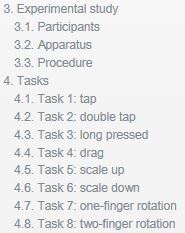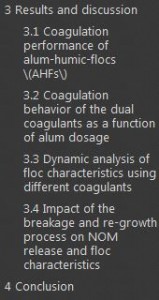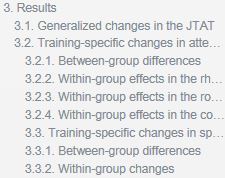 The Results section is where outcomes are communicated to the reader — and this is a critical concept: the Results section reports data generated by a method, in other words, outcomes. Do not include interpretation or speculation in this section.
The Results section is where outcomes are communicated to the reader — and this is a critical concept: the Results section reports data generated by a method, in other words, outcomes. Do not include interpretation or speculation in this section.
This does not mean there is no creative communication in the Results section! Humans are a visually-oriented species, so the wise writer uses figures and images to highlight the most important or interesting information. Creating figures is a strategic way of highlighting information by juxtaposing salient results without actually going so far as to provide interpretation. Images are prime real-estate in a report — do not use them to convey merely descriptive information, such as basic demographics of a participant population. Keep in mind that figures don’t act on their own. For every figure, graph, image, or photo, you need a sentence in the body of the results that references the figures and communicates why it’s there.
Mortality rate, body weight, and kidney weight of male offspring did not differ among the 4 groups (Table 1). At 12 weeks of age, systolic BP, which was exacerbated by postnatal HS intake, was higher in HF group than in control group (Fig. 1).[5]
Analysis: Each sentence above communicates the main idea the reader should take away from the figure/table. Note how each sentence objectively reports outcomes — no unnecessary description is included.
Organize the results from strongest to weakest or most relevant to least relevant (should these make sense for your data set). If you employed statistical analysis, then report significances when appropriate. In the example below, 2 paragraphs and several figures are used to communicate results. Each paragraph lays out the results of one aspect of the study (first, results according to demographic data; second, results of tests).
Mortality rate, body weight, and kidney weight of male offspring did not differ among the 4 groups (Table 1). At 12 weeks of age, systolic BP, which was exacerbated by postnatal HS intake, was higher in HF group than in control group (Fig. 1). Mean arterial pressure was higher in HF and HS groups than in control group. However, blood creatinine levels were not different among the 4 groups. These data indicated that HS intake aggravated HF-induced programmed hypertension but not renal function in 12-week-old offspring. From 4 to 12 weeks of age, systolic BP significantly increased in HS group compared with that in control group and was the highest in HF + HS group.
We next investigated whether HF and HS intake induced ADMA–NO imbalance. Plasmal-citrulline, l-arginine, ADMA, and SDMA levels and l-arginine-to-ADMA ratio were not different among the 4 groups (Table 2). To investigate mechanisms underlying programmed hypertension, we evaluated the renal mRNA expression of RAS components and sodium transporters. Postnatal HS intake significantly decreased the renal mRNA expression of Agtr1b and Mas1 and increased the renal mRNA expression of Ace compared with that in controls ( Fig. 2A). Renal mRNA expression of Ace andAgtr1a was higher in HF + HS group than in control group and that of Slc9a3, Slc12a1, and Atp1a1 was comparable among the 4 groups ( Fig. 2B). However, renal mRNA expression of Slc12a3 decreased in both HF and HS groups compared with that in control group. We analyzed the levels of sodium transporters and found that prenatal HF exposure significantly decreased the renal levels of NHE3 and NCC ( Fig. 3). However, renal levels of NHE3, NCC, and NKCC2 were significantly higher in HS and HF + HS groups than in HF group.[5]
Stylistics Note: The verbs in the Results section are mostly in active voice. This grammatical distinction points to a philosophical difference with the Methods. In the Results, the agents of the action are the researchers: they are the ones making the decisions, doing the analysis, etc. Thus, it makes good grammatical sense for them to also be the subjects of the sentence.
The Results section may also be divided according to subheadings when data falls into natural categories that will help a reader understand the outcomes in a particular way or if the methods create obvious divisions (usually according to a procedure or population). If these conditions are not met, then simply write the section using paragraphs. The example is taken from section 3.3 and demonstrates that Results were categorized according to major moves in the Procedures of the study as well as the Tasks.
 For each interaction, the system recorded the start time (seconds needed to go into action after the visual stimulus was shown), completion time, success (performed correctly or incorrectly), and the number of contacts with the surface (in order to know in an unsuccessful action whether the user had made any attempt to interact). A qualitative analysis was also carried out from the notes taken by an external observer during the experimental sessions.[4]
For each interaction, the system recorded the start time (seconds needed to go into action after the visual stimulus was shown), completion time, success (performed correctly or incorrectly), and the number of contacts with the surface (in order to know in an unsuccessful action whether the user had made any attempt to interact). A qualitative analysis was also carried out from the notes taken by an external observer during the experimental sessions.[4]

[1]
|
[2] |
[3]
|
[4]
|
[5] |
Results can be written using subheadings or as simple paragraphs.